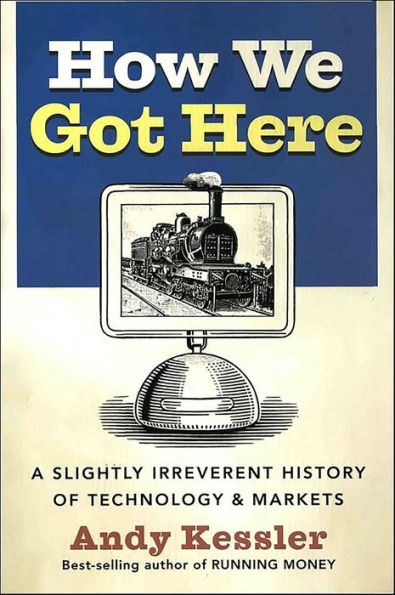Read an Excerpt
How We Got Here
A Slightly Irreverent History of Technology and Markets
By Andy Kessler HarperCollins Publishers, Inc.
Copyright © 2005 Andy Kessler
All right reserved. ISBN: 0060840978
Cannons to Steam
All it took was a little sunshine.
In 1720, the weather improved in Britain. No reason. The Farmer's Almanac predicted it. Crop yields went up, people were better fed and healthy. The plague, which had ravaged Western Europe, ended. Perversely, a surplus of agriculture meant prices dropped, and many farmers (of crops, not taxes) had to find something else to do.
Fortunately, there was a small but growing iron industry. Until the 1700s, metals like tin and copper and brass were used, but you couldn't make machines out of them, they were too malleable or brittle. Machines were made out of the only durable material, wood. Of course, wood was only relatively durable; wheels or gears made out of wood wore out quickly.
Iron would work. But natural iron didn't exist; it was stuck in between bits and pieces of rock in iron ore. A rudimentary process known as smelting had been used since the second half of the 15th century to get the iron out of the ore. No rocket science here, you heated it up until the iron melted, then you poured it out. Of course, heating up iron ore until the iron melts requires a pretty hot oven and to fuel it, a lot of charcoal, the same stuff you have trouble lighting at Sunday BBQ's. Charcoal is nothing more than half burnt wood but, as we all know, if you blow on lit charcoal it glows and gives off heat. So the other element needed to create iron is a bellows, basically, like your Uncle Ira, a giant windbag. Medieval uncles got tired really quickly cranking the bellows, so a simple machine, basically a waterwheel, was devised to crank the bellows, powered by running water. Hence, early ironworks were always next to rivers. This posed two problems, the iron ore came from mines far away, and after a day or two, the forest started disappearing around the mill and the wood needed for charcoal came from further and further away. It is unclear if ironworks sold their own stuff or if middlemen were involved. This raises the age-old question whether he who smelt it, well never mind.
Meanwhile, the iron you would get out of the smelter was terrible, about the consistency of peanut brittle; the sulfur content was high, because sulfur is in most organic material, especially trees, and the sulfur from the charcoal blended with the iron ore. It seems that wood refused to play a part in its own obsolescence for machine parts.
This pig iron, and lots of it, was used for cannons and stoves and things, but it couldn't be used for screws or ploughs or a simple tool like a hammer, which would crumble after its first whack.
Iron makers evolved their process, and added a forging step. If you hammered the crap out of pig iron, reheated it, and hammered it again, you would strengthen it each time until you ended up with a strong substance aptly named wrought iron. Besides gates and fences, wrought iron worked reasonably well for swords and nails and screws. But to create decent wrought iron, you really had to get the brittle out of the pig iron.
In 1710, Abraham Darby invented a new smelting process using coke, basically purified coal, instead of charcoal. The resulting pig iron was better, but not perfect. His son, Abraham Darby II improved on his dad's process and by mid-century, was oinking out pig iron usable for wrought iron, but only in small quantities. Unfortunately, like iron ore, coal was far away from the river-residing ironworks, so roads were built (sometimes with wood logs) and wagons brought coke to the river works. No surprise then that many ironworks moved to be near the coke fields. In 1779 Darby III would build the famous Ironbridge over the river Severn to transport materials with the iron supplied by the process his father and grandfather had developed. Heck of a family.
Demand for iron ore and coke took off and mining became a big business. One minor problem though, mines were often below the waterline and flooded constantly. This cut down on dust but too many miners drowned, hence the huge demand for something to pump out that water. The answer was a steam engine.
The concept of an engine run by steam had been around since the ancient Egyptians. It is not hard to image someone sitting around watching a pot of water boil and remarking that the steam coming off expands, and thinking, "Gee, if I could just capture that steam, maybe it would lift that big rock to the top of that pyramid." In fact, an Egyptian scientist named Hero living in Alexandria in 200 BC wrote a paper titled "Spiritalia seu Pneumatica," which included a sketch of steam from a boiling cauldron used to open a temple door. It looked like a failed seventh grade science fair project.
Not quite a couple of thousand years later, steam projects started boiling up again ...
Continues...
Excerpted from How We Got Here by Andy Kessler Copyright © 2005 by Andy Kessler.
Excerpted by permission.
All rights reserved. No part of this excerpt may be reproduced or reprinted without permission in writing from the publisher.
Excerpts are provided by Dial-A-Book Inc. solely for the personal use of visitors to this web site.



